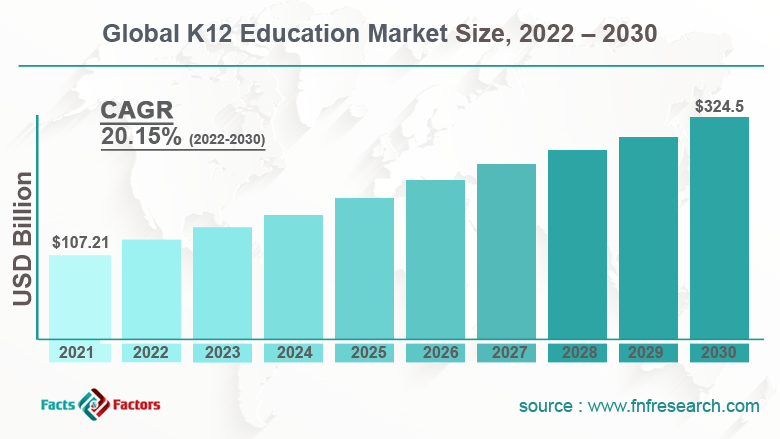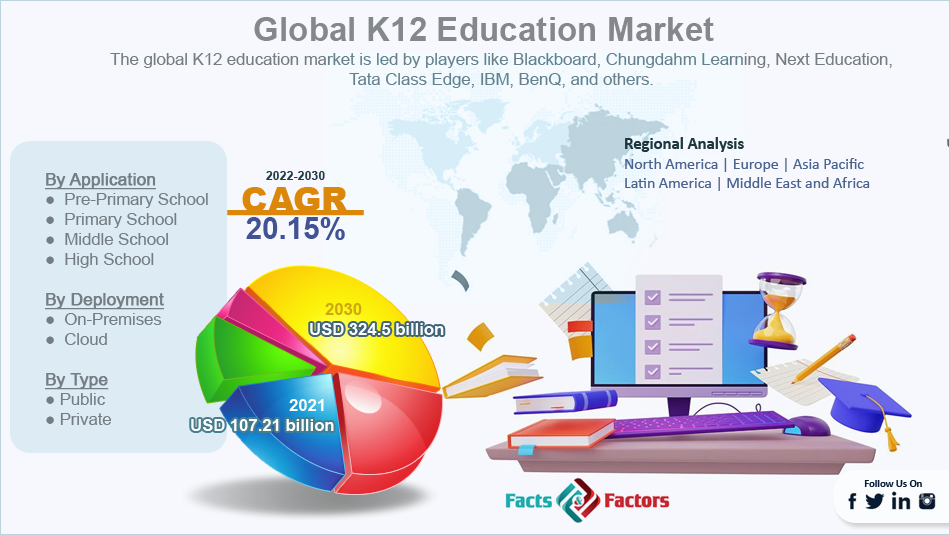Search Market Research Report
K12 Education Market Size, Share Global Analysis Report, 2022 – 2030

K12 Education Market Size, Share, Growth Analysis Report By Application (Pre-Primary School, Primary School, Middle School, and High School), By Deployment (On-Premises and Cloud), By Type (Public & Private), and By Region - Global and Regional Industry Insights, Overview, Comprehensive Analysis, Trends, Statistical Research, Market Intelligence, Historical Data and Forecast 2022 – 2030
Industry Insights
[226+ Pages Report] According to the report published by Facts and Factors, the global K12 education market size was worth around USD 107.21 billion in 2021 and is predicted to grow to around USD 324.5 billion by 2030 with a compound annual growth rate (CAGR) of roughly 20.15% between 2022 and 2030. The report analyzes the global K12 education market drivers, restraints/challenges, and the effect they have on the demands during the projection period. In addition, the report explores emerging opportunities in the K12 education market.

 Market Overview
Market Overview
The term K12 is used in educational settings across countries like Canada, the United States, and India to name a few. K12 in short is used to describe publicly supported school education systems before college admissions. The grades covered in K12 education are kindergarten (K) followed by first grade until 12th grade (1 to 12). This type of education system is generally divided into 3 categories. The first category is called elementary school and starts from grade K until 5th grade. The second category is a middle school or in some countries, it's referred to as junior high school which starts from grade 6th and lasts until 8th grade.
The last category is called high school and refers to students studying from 9th grade until 12th grade. In some cases, all three segments are referred to individually whereas in some cases, the middle and elementary grades may be combined. Some educational institutes offer all three categories on the same campus by combining the three segments. K12 forms the foundation of further studies and helps in shaping not only the intellectual strengths of the child but contributes to the overall personality development which determines the quality of life the child may live in the future. Each segment has its set curriculum which is dependent on the grade in which the child is studying.
 Key Insights
Key Insights
- As per the analysis shared by our research analyst, the global K12 education market is estimated to grow annually at a CAGR of around 20.15% over the forecast period (2022-2030)
- In terms of revenue, the global K12 education market size was valued at around USD 107.21 billion in 2021 and is projected to reach USD 324.5 billion, by 2030.
- The market is projected to grow at a significant rate due to the growing incorporation of technological systems for knowledge transfer
- Based on application segmentation, high school was predicted to show maximum market share in the year 2021
- Based on type segmentation, public school was the leading type in 2021
- On the basis of region, North America was the leading revenue generator in 2021

 Growth Drivers
Growth Drivers
- Growing incorporation of technological systems for knowledge transfer to propel market demand
The global K12 education market is projected to benefit from the growing allotment of funds for incorporating higher-grade technological systems to enhance the overall impact of knowledge transfer pursuits. Private and public schools have started investing resources in deploying methods that allow them to improve the quality of education they provide at the knowledge centers. Private centers are already well-funded and the amenities or access to advanced technology along with better exposure to the international curriculum are the main reasons why parents are willing to invest more in their children’s education.
However, over the last few years, state-funded schools have also received the necessary encouragement from ruling bodies that have emphasized the development of better learning management systems (LMS). Other factors like the incorporation of interactive training methods, investments in teacher training, the emergence of multiple private players offering extra tuition or assistance to students to help them perform better at examinations, along with monetary benefits provided by some state-bodies to encourage higher admission of students are factors that are expected to help the global market growth.
 Restraints
Restraints
- Overcrowding in schools to restricting market expansion
Many schools and teaching institutes have consistently complained about overcrowding issues in school centers, especially in public schools. Factors like an exponentially growing population, a rise in income, and the presence of a significant gap between the required number of education centers and the actual number of operations centers are the reasons why the reported incidents of overcrowding have increased in the last decade. This leads to the deterioration of the quality of education since teachers are unable to equally divide attention amongst the large group of students.
 Opportunities
Opportunities
- Urbanization to promote higher growth
Urbanization refers to the movement of people from rural areas to urban regions. As the world is registering a high rate of urbanization being observed worldwide, the global K12 education market may generate higher growth opportunities as guardians and parents are willing to spend on their child’s education. However, country leaders need to focus on developing the education system in rural areas as well since there is a large part of the population who may not have the same opportunity to move to bigger cities and every child owns the right to education independent of the place they live in.
 Challenges
Challenges
- Growing cases of bullying and imbalanced racial composition in schools act as a major challenge
One of the key challenges in the global market is the growing number of reported cases related to child safety which is in terms of bullying. There have been multiple incidences in which children were exposed to unfriendly behavior of educators or fellow students based on gender, appearance, financial status, and other factors. As per Theirworld more than 18 million girls who are in the age group of 15 to 19 years have suffered from sexual abuse leading to a surge in the number of school dropouts. These incidents can have a long-term impact on the child’s psychology and impact their overall growth.
 Segmentation Analysis
Segmentation Analysis
The global K12 education market is segmented based on application, deployment, type, and region
Based on application, the global market is divided into pre-primary school, primary school, middle school, and high school.
- The global market is most highly dominated by the primary school, middle school, and high-school segment due to the high influx of students in these units as compared to pre-primary where the children are too young and lack the emotional well-being to stay away from the comfort of their homes
- However, the growing number of families where both parents are working and have less time to stay at home could propel revenue generation in the pre-primary segment
- As per Hindustan Times, more than 25 crore students enrolled in classes from primary to secondary levels in 2021-2022
Based on deployment, the global market is segmented into on-premises and cloud
Based on type, the global market is divided into public and private
- The global market registered the highest growth in the public school segment since many countries provide free education until 12 standard
- Although in certain countries like India, most parents prefer to send their children to private schools that have better amenities and teaching staff than public schools, especially in urban areas that are fast-growing
- India currently has more than 15 lakh private schools
 Recent Developments:
Recent Developments:
- In April 2022, Vega Schools, a popular chain of private, co-educational K-12 schools in India, unveiled a new campus in Gurugram, a planned city in the Haryana state of India. The new K-12 campus will adopt research-based methods of conducting educational classes that are anticipated to generate an inquiry-based learning, experiential learning, and project-based learning ecosystem
- In December 2021, Jain Group, an entrepreneurship incubator, and education provider in India, launched JIRS Hybrid which is a joint venture between the Jain International Residential School collaboration with Crimson Education, an organization led by researchers and educationists working toward school development
 Report Scope
Report Scope
Report Attribute |
Details |
Market Size in 2021 |
USD 107.21 Billion |
Projected Market Size in 2030 |
USD 324.5 Billion |
CAGR Growth Rate |
20.15% CAGR |
Base Year |
2021 |
Forecast Years |
2022-2030 |
Key Market Players |
Blackboard, Chungdahm Learning, Next Education, Tata Class Edge, IBM, BenQ, and others. |
Key Segment |
By Application, Deployment, Type, and Region |
Major Regions Covered |
North America, Europe, Asia Pacific, Latin America, and the Middle East &, Africa |
Purchase Options |
Request customized purchase options to meet your research needs. Explore purchase options |
 Regional Analysis
Regional Analysis
- North America to witness the highest growth during the forecast period
The global K12 education market is expected to witness the highest growth in North America with the United States and Canada leading the regional market. Public schools in many North American regions are state-funded and free for students which is a major reason for the registered growth further propelled by the various initiatives rolled out by the state governments to encourage and aid higher access to quality education. The educational system in North America is more inclusive of technological systems to aid effective knowledge transfer which in collaboration with the increasing use of digital systems for conducting sessions may aid addition of higher revenue.
Asia-Pacific is set to emerge as a dominant region during the forecast period mainly driven by the growing urban population along with consistent and significant growth in online learning. India is projected to become a lucrative economy in the region due to the rapidly increasing government initiatives.
 Competitive Analysis
Competitive Analysis
- Blackboard
- Chungdahm Learning
- Next Education
- Tata Class Edge
- IBM
- BenQ
The global K12 education market is segmented as follows:
 By Application Segment Analysis
By Application Segment Analysis
- Pre-Primary School
- Primary School
- Middle School
- High School
 By Deployment Segment Analysis
By Deployment Segment Analysis
- On-Premises
- Cloud
 By Type Segment Analysis
By Type Segment Analysis
- Public
- Private
 By Regional Segment Analysis
By Regional Segment Analysis
- North America
- The U.S.
- Canada
- Mexico
- Europe
- France
- The UK
- Spain
- Germany
- Italy
- Nordic Countries
- Denmark
- Sweden
- Norway
- Benelux Union
- Belgium
- The Netherlands
- Luxembourg
- Rest of Europe
- Asia Pacific
- China
- Japan
- India
- Australia
- South Korea
- Southeast Asia
- Indonesia
- Thailand
- Malaysia
- Singapore
- Rest of Southeast Asia
- Rest of Asia Pacific
- The Middle East & Africa
- Saudi Arabia
- UAE
- Egypt
- South Africa
- Rest of the Middle East & Africa
- Latin America
- Brazil
- Argentina
- Rest of Latin America
Industry Major Market Players
- Blackboard
- Chungdahm Learning
- Next Education
- Tata Class Edge
- IBM
- BenQ
Frequently Asked Questions

Copyright © 2023 - 2024, All Rights Reserved, Facts and Factors


